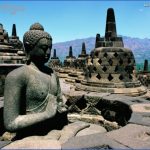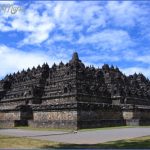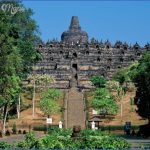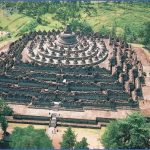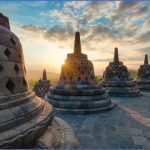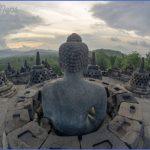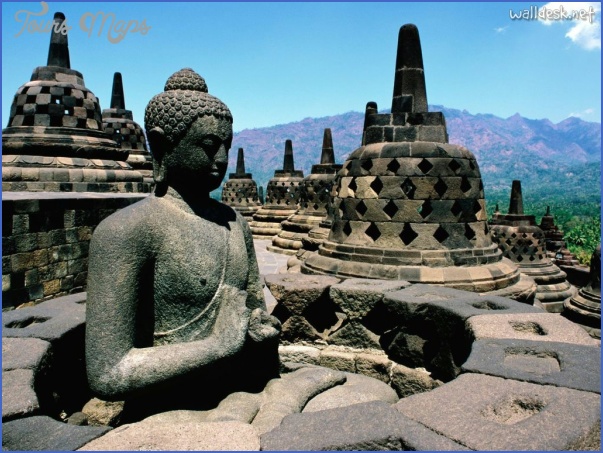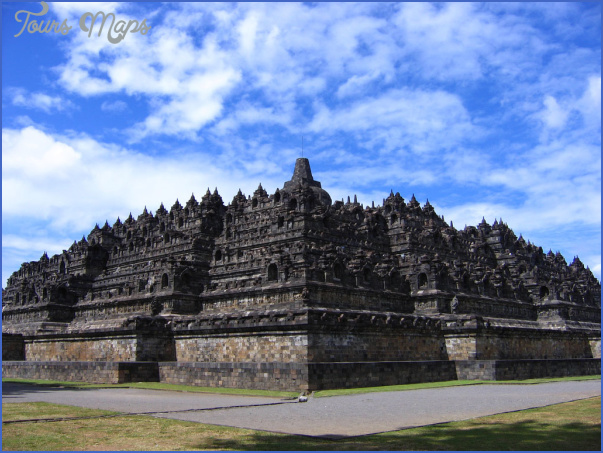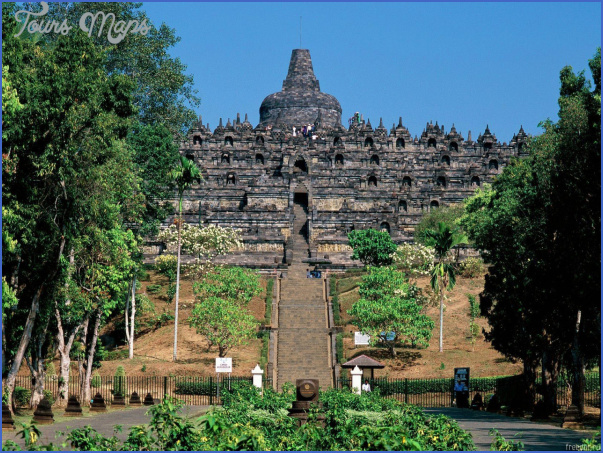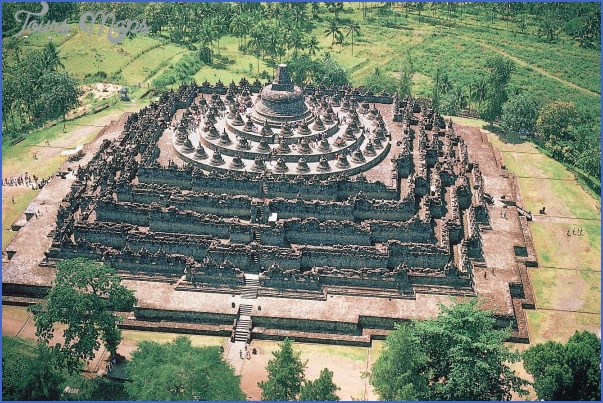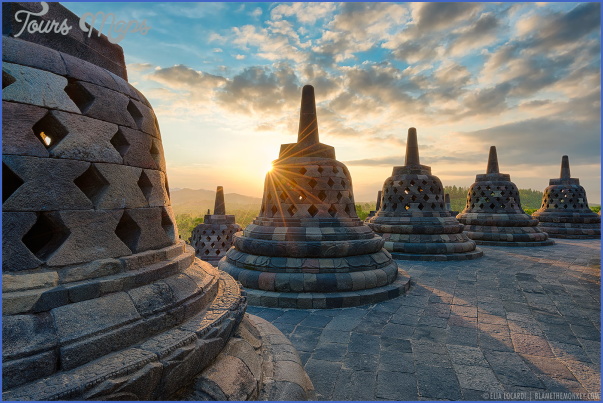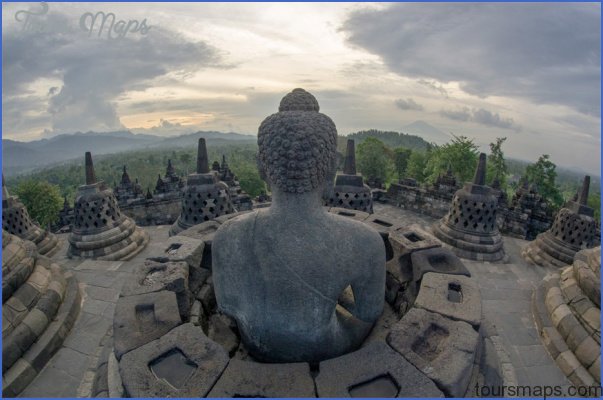Borobudur
c. 825 CE TEMPLE MAGELANG, JAVA, INDONESIA
ARCHITECT UNKNOWN
The world’s greatest Buddhist monument, Borobudur is a vast 9th-century temple that combines a stupa (shrine to the Buddha), a pilgrimage site, and a three-dimensional symbol of Buddhist beliefs. Built on a hill, it is an enormous pyramid adorned with elaborate carved reliefs and houses statues of the Buddha.
No one knows when Borobudur was built or by whom, but construction seems to have been completed around 825 ce under the Sailendra dynasty, a family of powerful rulers who promoted Mahayana Buddhism. Their architects took an existing Buddhist form, the stupa, and developed it.
A traditional stupa is a mound containing sacred remains. At Borobudur the stupa is the size of a small hill and consists of a series of open stone terraces or galleries, which divide the monument into levels.
Each level symbolically represents the realms or states of existence in
ON CONSTRUCTION
Borobudur does not have an interior. It consists of an earth mound supporting open-topped terraces. To construct these terraces, the builders quarried a vast amount of local stone. They shaped the blocks individually to fit together like jigsaw pieces, laying them without mortar. At some stage, the design was modified. The monument’s lowest level, the base, extends some distance out from the main structure and was added later. In the late 19th century restorers discovered an original base, decorated with relief carvings, buried beneath the later stonework of the lowest level. No one knows why this was hidden. It may have been because the structure needed strengthening or because there was some religious imperfection in the original work.
Buddhist cosmology. The building’s base symbolizes the realm of desires where most mortals live. The next five levels, made up of terraces on a square plan, represent the world of forms, a place attained by Buddhists who have overcome desire. This section bears carved reliefs narrating the story of the Buddha’s life and other subjects from Buddhist scriptures. The three circular galleries make up the final level, which denotes the formless realm-the state of nirvana to which Buddhists aspire. This part houses 72 statues of the Buddha kept beneath pierced stone canopies, each in the shape of a stupa.
Pilgrims followed a set route, walking around the lower levels, looking at the carved reliefs, and absorbing the story of the Buddha before rising to the higher levels. The changing galleries and the simplification of the sculpture gave pilgrims a sense of the spiritual development needed to ascend from the realm of desires to higher levels.
Base added later Main dome Circular platform Square platform Visual tour
3 GUARDIAN LION Borobudur has several carved lions, which stand as guardians on and near the temple. Although extensively carved, the statues are not very realistic lions were not indigenous to Indonesia, and the carvers, who may never have seen real ones, produced stylized portrayals. Lions were symbols of bravery. They were also linked to royalty and appear on some of the thrones shown in Borobudur’s relief sculptures. Buddha was sometimes said to have had the voice of a lion.
1 ARCH OF KALA This gate takes the form of the face of Kala (time), a complex being who appears in both Hindu and Buddhist mythology. In Buddhism Kala is said to devour the obstacles that stand in the way of enlightenment. In Hindu mythology Kala is also identified with a demon called Rahu, who stole the elixir of life from the gods and was decapitated by Vishnu but lived on because he had already drunk the magic potion. He is therefore a symbol of immortality, and the jewels and ornaments on his face represent the elixir. The face of Kala often appears on mandalas, sacred diagrams based on circles and other shapes, which are used in meditation and spiritual teaching. Seen from above, with its combination of circles, squares, and other shapes, Borobudur bears a close resemblance to a mandala.
4 LIFE OF BUDDHA A series of reliefs on the lower levels of Borobudur show episodes from the life of the Buddha. They tell the story of Prince Siddhartha’s birth and early life, his renunciation of his royal life, his travels as a wandering monk and searcher for truth, and his eventual enlightenment. In this panel he is teaching some of his disciples. Many of the reliefs illustrate the events against a vivid background of trees and plants, all of which are beautifully carved.
3 BUDDHA STATUE All the carvings of the Buddha at Borobudur look similar, but there is some variation in the mudras (symbolic hand gestures) of the figures. The statues on the upper levels show the Buddha making a gesture that symbolizes the turning of the wheel of the doctrine. This is the mudra associated with the Buddha’s preaching of his first sermon, which according to some traditions, was delivered from the top of Mount Sumeru. The use of this mudra is a reminder that understanding his words and following his path will lead his followers toward salvation.
1 SHIP The reliefs depict many details of contemporary life, from the furniture and decoration of the royal palace to the life of the forest and the sea. Intricate carvings of sailing boats show the kind of water transport available when Borobudur was built. This ship, carved on the main wall of the first gallery, has several sails and an outrigger, like many vessels used in Southeast Asia.
1 UPPER LEVELS STUPAS The top
levels of the monument are ringed with small bell-like stupas with diamond-shaped openings that reveal the Buddha statues inside. At the very top is a single large stupa, similar in form to some in India. This pinnacle recalls Mount Sumeru, the great mountain at the center of the world of Mahayana Buddhism. It is a reminder that Borobudur is a symbol of the cosmos and that its builders were the Sailendra kings, known as Lords of the Mountain.
3 STUPA REMOVED Some of the openwork stupas on the upper levels no longer survive, allowing visitors to see the Buddha statues more clearly. The removal of these structures also reveals how the masonry fitted together with the help of the holes carved in the circle of stones at the stupa’s base.
BOROBUDUR INDONESIA Photo Gallery
Maybe You Like Them Too
- The Best Cities To Visit in The World
- World’s 10 Best Places To Visit
- Coolest Countries in the World to Visit
- Travel to Santorini, Greece
- Map of Barbados – Holiday in Barbados

